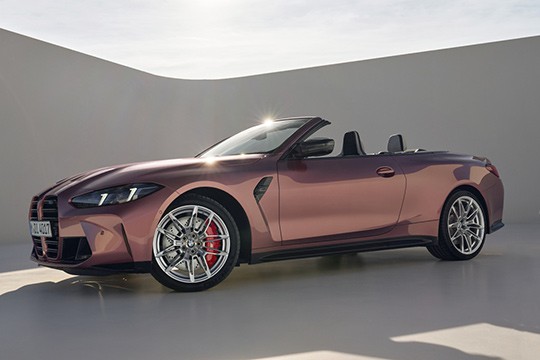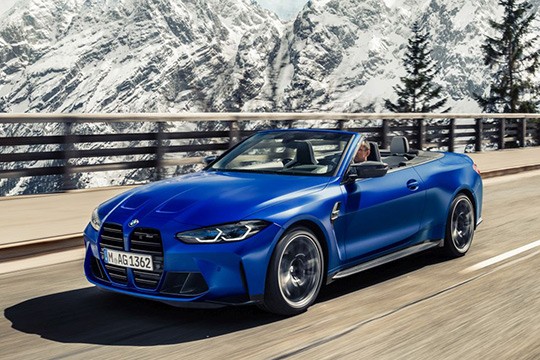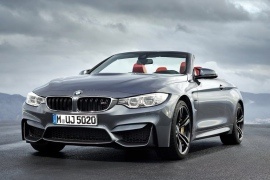BMW M4 Convertible Models/Series Timeline, Specifications & Photos
First production year: 2014
Engines: Gasoline
Body style: Convertible (spider/spyder, cabrio/cabriolet, drop/open/soft top)
Even though the open-top versions of the M4 were not the fastest ones in the family, they were appealing to those looking for fast cars that could be driven with their tops down.
After BMW introduced the M4’s first generation in 2014, it quickly came with an open-top version known as the M4 Convertible. Then, in 2020, the German automaker launched the second generation of the 4 Series, followed by the M4 G82 in late 2020 for the 2021 model year. Just 27 months later, in early 2024, BMW unveiled the facelifted version of the M4 in both coupe and convertible shapes. Besides the usual aesthetic updates, the automaker also offered more ponies under the hood and some interior improvements.
While the car’s front wasn’t everyone’s cup of tea, the automaker insisted on keeping the same tall kidney grille adorned by horizontal slats. Unlike its predecessor, the 2024 M4 Convertible featured standard LED headlights with a new design, even though they kept the same swept-back shape as its predecessor. As an option, customers could get them with laser lights, which improved nighttime driving.
From its profile, the 2024 M4 Convertible was fitted as standard with 18-inch wheels at the front and 19-inch at the rear, with an option for a set with 19 inches up front and 20 inches in the back. Behind the rear wheels, the automaker installed an exhaust vent, enhancing the car’s look. The thicker A-pillars of the windshield, compared with the coupe, served as a rollover safety arch. Drivers could open or close the retractable hard top in 18 seconds at speeds of up to 50 kph (31 mph). Out back, the car featured LED taillights, but BMW also offered customers the option to have them fitted with laser diodes and fiberglass inserts that created a 3-D effect. Underneath the bumper, flanking the diffuser, the automaker installed the quad exhausts system.
Inside, BMW introduced a new dashboard design that featured a curved, wide display. There were actually two screens, one in front of the driver and a touchscreen atop the center stack, under the same piece of glass. The infotainment system was based on BMW’s iDrive 8.5 OS. Just like its sibling, the M4 Convertible was fitted as standard with a leather-wrapped steering wheel with paddle shifters behind it for vehicles featuring automatic transmissions. An Alcantara-wrapped steering wheel was also available. Like its coupe sibling, the convertible had a pair of sports seats up front and a bench seat profiled for two in the back. Still, the legroom was not big enough for adults on long journeys.
Under the hood, BMW installed the same inline-six S58 bi-turbocharged engine from the previous model. Depending on the version, this powerplant delivered 480 PS (473 hp), 510 PS (503 hp), and 530 PS (523 hp) for the manual transmission, the eight-speed automatic gearbox xDrive version, or the eight-speed gearbox and all-wheel drive version, respectively.
BMW M4 Convertible Competition 3.0L M xDrive 8AT AWD (530 HP)
BMW introduced the third body version of the M4 in late spring of 2021 with the addition of an open-top vehicle, completing the lineup.
When the German carmaker decided to change the M3 nameplate from the coupe, its fans were upset. Yet, it didn't change its mind and produced the M4 as a coupe and Gran Coupe. While the former was already known on the market, the latter wast a four-door fastback fake coupe with a sloped rear liftgate.
In the new clothing, the topless M4 kept the same core values from the Coupe at the front, with the twin kidney-grilles and the aggressive-looking LED headlights. Its panel soft-top could have disappeared in 18 seconds, at speeds up to 50 kph (31 mph). The new retractable roof featured a new technology that made it lighter than a hard-top and better insulated than a three-layer fabric one. BMW installed a new trunk lid at the back, which was flatter than on the M4 Coupe.
Inside, there were more standard features for the four-seat convertible. Gone were the analog dials; hence the M4 convertible received a standard digital TFT instrument panel. BMW installed a 10.1" infotainment display above the center vents. The carbon fiber and aluminum trims were also standard, along with the sport bucket seats. Behind the cabin, the carmaker managed to fit a 300 liters (10.6 cu-ft) trunk with the roof down and 385 liters (13.6 cu-ft) with the top up.
The drivetrain was similar to the one fitted on the M4 Coupe, with only one difference: it was all-wheel-drive without the possibility to disengage the front wheels, as in the hard-top version.
BMW M4 Competition Convertible M xDrive 3.0L 8AT AWD (510 HP)
BMW introduced the M-version of the 4 Series at the 2014 Los Angeles Auto Show, continuing the saga of M-powered convertibles initiated by the E30 M3 during the ‘80s.
When the German automaker shuffled the nameplates and introduced the 4 Series on the market in 2014, many of the brand’s aficionados had to understand that their beloved 3 Series was no longer available with a two-door bodywork. As a result, they either changed their minds and took the 4 Series or had to take the 3 Series as a sedan or a station wagon. But they adapted, and soon they started to understand the change and, disregarding the nameplate, they went for the 4. Moreover, the M3 Coupe was also deleted and replaced by the M4 in both variants: coupe and convertible.
Weighing about 250 kilograms (551 lbs.) more than its coupe sibling, the M4 Convertible wasn’t light on its feet. Still, the design was similar, and the option of having a retractable hard top was appealing. Thus, BMW customers were ensured that the car could keep them warm during winter and still enjoy the open-sky driving experience when the weather allowed it. The car’s front featured the same headlights pinched on their inner side at the front that flanked the kidney grille. Below, on the bumper, BMW installed a wide center air intake that helped the engine stay cool and a set of side scoops that fed the front rotors with fresh air. From its profile, the thicker A-pillar was raked and also served as a safety system, and there was no other pillar on the rest of the vehicle. Just like its coupe sibling, the M4 Convertible featured extracting vents on the front fenders and specific side sills. At the back, unlike other open-top 4 Series vehicles, the M4 boasted a four-exhaust system that flanked a diffuser underneath the bumper.
Inside, the automaker installed high-bolstered front seats that could keep their occupants in place during high-speed cornering maneuvers. At the same time, in the back, the automaker had to push the bench seat forward to maker room for the retractable roof. As a result, the legroom was not that big despite the car’s long wheelbase. But it was adequate for two people on short jaunts. The driver enjoyed an analog instrument cluster fitted with large dials for the speedometer and tachometer. The onboard computer could display additional information on a separate LCD installed underneath the dials. Atop the center stack, BMW installed the infotainment’s system screen, which the front occupants could control via a rotary knob housed by the center console. Since this was the sportiest version of the 4 Convertible, the automaker offered carbon fiber trims and standard leather upholstery.
Under the hood was the known turbocharged inline-six powerplant that provided 431 PS (425 HP) to the rear wheels via a six-speed manual or a seven-speed M Double Clutch gearbox. BMW installed an electronically controlled multi-plate limited-slip differential.


